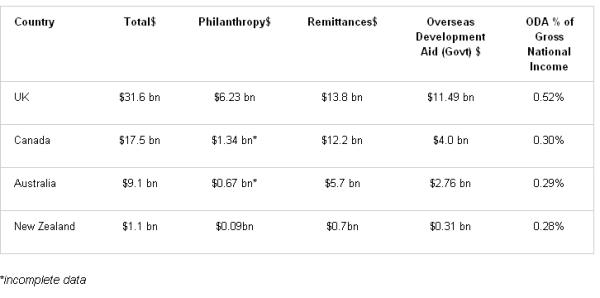A couple of very interesting reports on international aid have recently been released.
In May this year, the Hudson Institute a non-partisan policy research organisation based in USA launched its sixth annual Index of Global Philanthropy and Remittances 2011. This fascinating global index was particularly interesting this year as it charts the results of government aid or official development aid (ODA), philanthropy and remittances (transfer of money by a migrant or foreign worker to his or her home country) from a number of OECD countries to the developing world in 2009.
While on 6 July 2011 the Minister of Foreign Affairs, Mr Kevin Rudd released the report "An Effective Aid Program for Australia: Making a real difference-Delivering real results". This is the Australian Government's response to the "Independent Review of Aid Effectiveness". The Government accepted 38 of the 39 recommendations.
Advertisement
Results from the Index of Global Philanthropy and Remittances show that despite the global financial crisis, in 2009 philanthropy held even, while remittances showed a small decline. However they understand that remittances have grown in 2010 and are expected to increase in 2011.
Most significant nearly 80% of the developed world's total economic engagement with the developing world is through private financial flows, including private investment, philanthropy and remittances.
The following information selected from a number of wonderful charts in the report provides some key comparative data:

What is clear is that developed countries give far more to developing countries through private actors than through government aid. Whether it is investment, remittances and private philanthropy – or just remittances and private philanthropy – it far exceeds official development aid (OAD). "This reflects the diverse new world of international development where for-profits, not-for-profits, churches, universities, families and individuals can and are contributing to international relief and development in the developing world."
Clear trends apparent in the research show the increasing impact and sophistication of philanthropic partnerships, including the use of cutting-edge technology-based solutions. "This creativity is partly due to the increase in social entrepreneurs in foreign aid who are redefining philanthropy just as philanthropy redefined foreign aid." The report states that there is increasing recognition that the attributes fostered by private giving – results, transparency, grass-roots involvement, and creating lasting institutions – are being embraced by the international development community.
Advertisement
A clear international agenda for aid effectiveness has emerged and the Australian Government's report An Effective Aid Program for Australia: Making a real difference-Delivering real results" demonstrates this influence.
The Government confirmed that the fundamental purpose of Australian aid is to help people overcome poverty noting that this also serves Australia's national interests by promoting stability and prosperity both in our region and beyond. The Government will focus our effort in areas where Australia can make a difference and where our resources can most effectively and efficiently be deployed.
One of the most striking changes over the past five years has been the dramatic rise in the proportion of the program going through multilateral, NGO and government partners. In 2005, over 40 per cent of aid from AusAID was spent through contractors; now it is just over 20 per cent. The report notes that in several respects this shift has been highly successful, but there is scope to make better use of existing partnerships and include new partners, particularly the private sector and community groups.
A central feature of Australia's aid program is the rapid growth underway in the aid budget. In 2010–11, this stands at approximately $4.3 billion, or 0.33 per cent of Gross National Income. This represents a doubling of Australian aid over the past five years in absolute dollar terms. The government's commitment to reach 0.5 per cent of GNI by 2015–16 will, subject to future levels of economic growth, see the aid budget almost double again, to around $8 billion.
This article was first published on July 8, 2011 on the blog of the Centre for Social Impact.
Discuss in our Forums
See what other readers are saying about this article!
Click here to read & post comments.